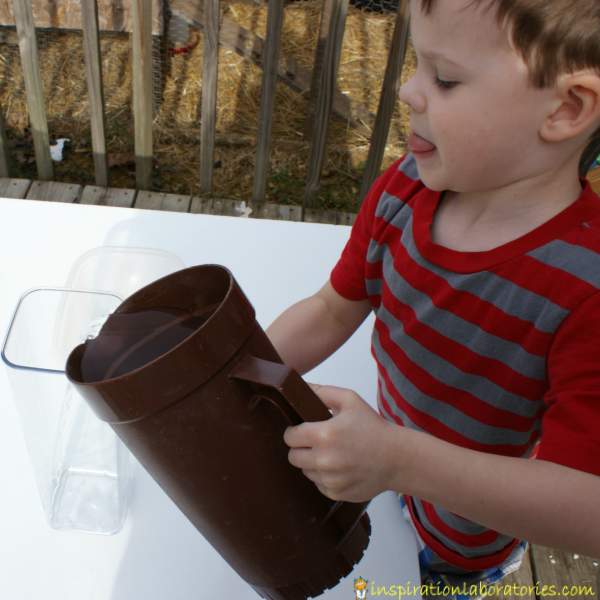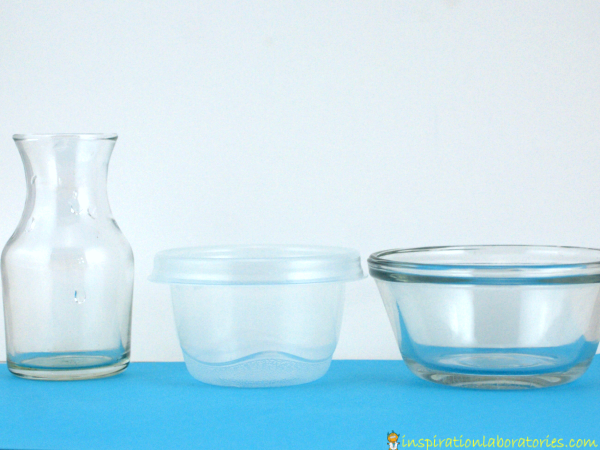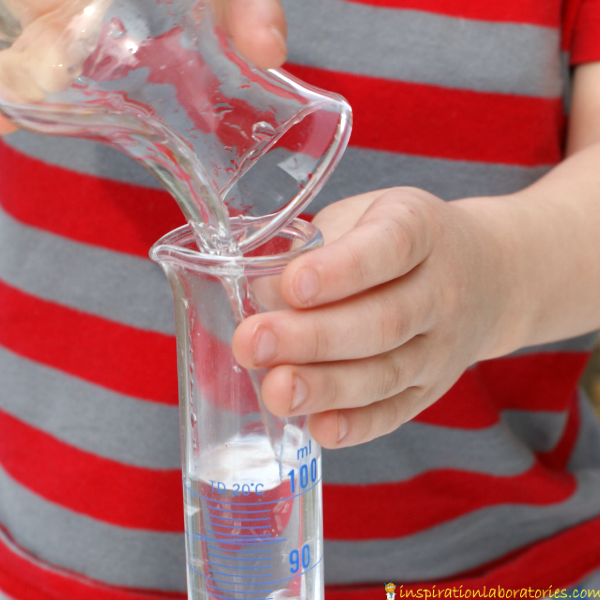V is for Volume
The A to Z Science series for toddlers and preschoolers at Inspiration Laboratories continues with the letter V. V is for Volume.

V is for Volume
Volume is the amount of space an object takes up or surrounds. Volume is not dependent on the mass of the object only the three dimensional space. It can be a challenging topic for young children to understand. The activities below introduce the concept of volume and address some common misconceptions.
Which Container Has the Greater Volume? Short vs. Tall
You’ll Need:
- a tall, thin container
- a short, wide container
- measuring cup (4 cups or larger if you have it)
- water
For this activity, I used two 8 cup containers. The tall container was for holding pasta. The short container was an everyday, rectangular storage container.

Ask your child which container has the greater volume – the tall container or the short container.
Have your child fill the tall container with water.

Measure how much water the tall container holds by using the large measuring cup. Our tall container held 8 cups of water.
Pour the water from the measuring cup into the short container. How many cups does it hold?

Our short container also held 8 cups of water. Which container has the greater volume? Which can hold more water? Neither. They have an equal volume. (Aiden said it was a tie.)
Science Note: This activity addresses a common misconception children have regarding volume. Young children often believe that a taller container will have a greater volume than a shorter container. They only consider one dimension (the height). In our investigation above, both containers had the same volume. They held the same amount of space. Even after seeing that both containers hold the same amount, some children will still maintain the taller container holds more. It may take measuring the water a few times before they get it.
Repeat this investigation with other containers – larger bowls, smaller bowls, etc.

Have your child predict if the new containers will hold more or less water than the 8 cup containers.
Use measuring cups to determine which holds more.
Which Container Has the Greater Volume? Comparing Similar Sizes

You’ll Need:
- 3-4 similar sized containers (small ones are fine)
- measuring cups and/or graduated cylinders
- water
Ask your child which of the containers has the greatest volume – which can hold the most water?

Allow your child to design a way to figure it out.

Aiden poured water from one container into the next and observed that they held about the same amount of water.

He poured the water from the 2nd container into the 3rd container and observed that there was still room for more water.

The 3rd container held the most water, so it had the greatest volume.
Aiden also used the graduated cylinders to measure the water he used. I talked to him about how to use the graduated cylinder. You look at the line closest to the bottom of the water. He didn’t pay much attention to this when he was adding water to the graduated cylinder. He would always stop at the number (which was above the line). That’s ok. He was working on pouring skills. We can revisit how to measure accurately in the future.

Explore on Your Own
Set out different containers and allow your child to pour water from one container to another. She will start to observe that one container holds more than another based on how she can fill it up. You can ask questions about the containers and talk about volume if you want.
Be sure to subscribe to our weekly newsletter and get exclusive science explorations for young scientists in each issue.
![]()

Leave a Reply